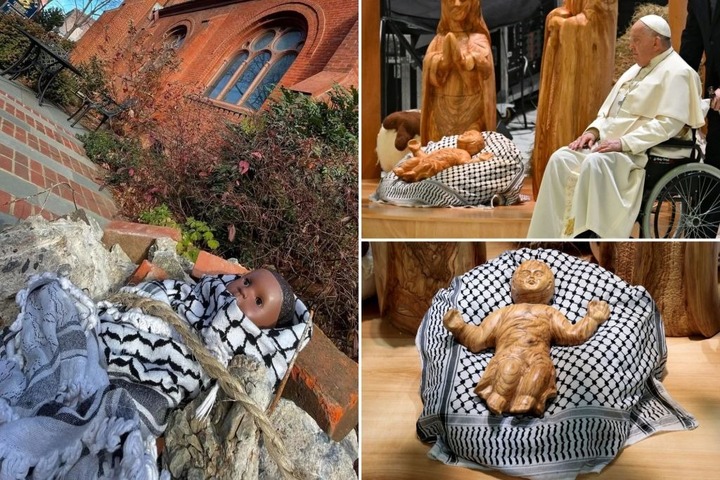The traditional Christmas nativity scene, depicting the birth of Jesus, has been reinterpreted this year in a manner that has sparked significant controversy. Several churches, including even the Vatican, have featured “Christ in the Rubble” displays, where the baby Jesus is wrapped in a keffiyeh, a traditional Arab headdress that has become a symbol of Palestinian solidarity, and the manger rests amidst rubble, representing the ongoing conflict in the region. This modification, intended to symbolize the suffering of Palestinians and suggest that Jesus, if born today, would be born into the conflict, has ignited a fierce debate about the politicization of a sacred religious symbol.
The origin of these modified nativity scenes can be traced to Munther Isaac, a Palestinian pastor who introduced the concept last Christmas. Isaac argues that the modern-day situation in Bethlehem, the birthplace of Jesus, is one of conflict and suffering, and the revised nativity scene reflects this reality. He views the scene as a message of Jesus identifying with the suffering of Palestinians. Isaac’s message has resonated with some congregations worldwide, who have adopted similar displays, prompting discussions about the intersection of faith, politics, and current events. However, the displays, especially the one briefly featured in St. Peter’s Square, have drawn sharp criticism for seemingly exploiting the nativity for political purposes and for what some perceive as a deliberate misrepresentation of historical context.
Critics argue that the depiction of Jesus wrapped in a keffiyeh is not only ahistorical but also promotes a narrative that erases the Jewish identity of Jesus. They emphasize that Jesus was a Jew, born in a Jewish town, and the nativity story should be presented as such, without being infused with contemporary political narratives. This concern is particularly strong given the historical and religious significance of Bethlehem for both Jews and Christians. The use of the keffiyeh, a potent symbol in the Israeli-Palestinian conflict, transforms the nativity scene from a purely religious depiction into a political statement, a move that many find deeply objectionable. Furthermore, associating the baby Jesus with a symbol of resistance, as critics argue the keffiyeh represents in this context, is seen as a distortion of the biblical narrative.
The Vatican’s brief inclusion of a keffiyeh-clad Jesus in its nativity scene added fuel to the controversy. Coming after Pope Francis’s comments suggesting potential Israeli genocide in Gaza, the display was interpreted by some as part of a pattern of concerning statements from the Pope regarding the Israeli-Palestinian conflict. Critics felt the Vatican’s choice lent credence to narratives that seek to diminish the Jewish connection to the land of Jesus’s birth. While the display was not the main nativity scene at St. Peter’s Square and was removed relatively quickly following backlash, its presence, however brief, amplified the debate significantly. The incident highlighted the potential for religious symbols to be misinterpreted and appropriated for political agendas, underscoring the sensitivity surrounding the Israeli-Palestinian conflict.
The core issue at stake is the perceived politicization of a deeply religious symbol. While some argue that the “Christ in the Rubble” displays are a legitimate expression of solidarity with the suffering of Palestinians and a reminder of the political context surrounding Jesus’s birth, others contend that it is a manipulative distortion of history and a sacrilegious use of a sacred narrative. The debate extends beyond the specific imagery of the keffiyeh and rubble to encompass broader questions about the role of religion in political discourse and the responsibility of religious leaders to avoid perpetuating potentially harmful narratives. The controversy raises complex questions about how to balance acknowledging the historical and present-day political realities of the Holy Land with the need to preserve the integrity of religious traditions.
The controversy surrounding the “Christ in the Rubble” nativity scenes underscores the complex and often fraught relationship between religion and politics, particularly in the context of the Israeli-Palestinian conflict. The debate highlights the potential for religious symbols to be interpreted and utilized in ways that can either promote understanding and empathy or exacerbate existing tensions. While some view the modified nativity scenes as a powerful statement of solidarity with a marginalized community, others see them as a deliberate misrepresentation of history and a cynical exploitation of religious tradition. The intensity of the reactions on both sides underscores the deeply held beliefs and sensitivities surrounding this issue and the ongoing challenge of navigating the intersection of faith, politics, and social justice.










